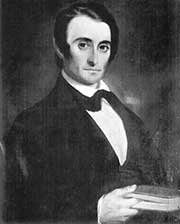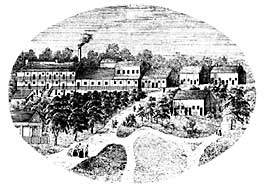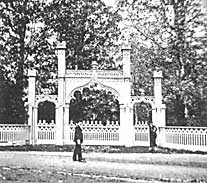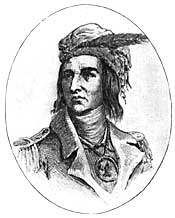                                                                  |
|
Installment
1: 1803 to 1853
 |
|
|
William
Mills—
‘The
Yellow Springs man’
Judge William Mills, whose beloved estate once stood at the center of
Mills Lawn, was not the first patron of Yellow Springs. Even his father,
Elisha Mills, who built up the spring resort, was not the first to draw
people to what is known today as Glen Helen. But Judge Mills may be considered
the village’s founder because of the determination he showed during
America’s thrust westward to make Yellow Springs a permanent place
of healthy commerce and national recognition.
At the beginning of the 19th century, a wealthy German entrepreneur from
Cincinnati named Martin Baum, a Greene County surveyor named Lewis Davis
and Davis’s brother-in-law Benjamin Whiteman, one of the county’s
first judges, purchased the area around the Yellow Spring and Miami Township.
The mythical appeal of the ochre-colored spring, which was said to cure
any ill, drew many of Baum’s wealthy acquaintances from Cincinnati,
who traveled by stagecoach lines to stay at Davis’s inn by the spring.
An early account of the area given in Mrs. S. V. Cox’s “The
Story of Whitehall” says that a settler from Cincinnati named Benjamin
Drake “described Xenia as a village whose loitering population gave
more evidence of content than commerce.”
“Independent, however, of the curative power of this water, a summer’s
visit to Yellow Springs has many charms,” Drake said. “The region
in which it is situated is cool and healthful, being elevated near a thousand
feet above New Orleans, and it has wild and romantic scenery with cliffs,
waterfalls, babbling brooks, and flowering prairies, and the pleasant
villages of Springfield, Xenia, Dayton, and Clifton within an afternoon’s
drive.”
In 1805, Thomas Fream was appointed the first postmaster of the area.
According to Cosmelia Hirst’s 1895 scrapbook, Fream owned a trading
post and general store north of the Glen on a hill near the Springfield
stage road and was said to have given Yellow Springs its name. The name
Ludlow appeared in this area’s postal records between 1817 and 1823.
However, it is unclear whether the postal routes referred to the village
or more specifically to the post office itself.
When the Connecticut lawyer Elisha Mills came east with his family to
Cincinnati in 1826, he read in a newspaper that the land around the Yellow
Springs was for sale. He bought the tracts including the Glen and Yellow
Spring, for $6,135, and by 1829 was advertising his auspicious “water
cure” spa, just a day’s ride north by coach from Cincinnati.
 |
|
The old Neff House, which served as Mills’s
“water cure” spa in the Glen.
|
In contrast to the
show of wealth and leisure made by spa visitors, life for the 100 or so
local residents was modest and rugged. Jane Hill Baker references the
characteristics of the day for the 1830’s frontiers- men and women
in her 1974 thesis on William Mills. The general store not far from the
spring, she wrote, stocked only practical necessities such as yard goods,
powder and lead for hunting and some food items. Oats and corn cost 8
cents a bushel, eggs were 2 or 3 cents per dozen, pork went for $1.50
per one-hundred weight and whiskey was 15 cents a gallon. Bartering and
mutual labor was more common than using money. It took five days for the
mail to arrive from Washington, seven from New York.
It was in these times and circumstances, according to R. Straker in Horace
Mann and Others, that William Mills spent his formative years, walking
or riding on horseback to Springfield every week to study with Judge Torbet,
who later became Springfield’s first mayor. Mills studied classics
at Kenyon College in 1832 and then at Miami University, never graduating,
before becoming postmaster here in 1835. He was later known as Judge Mills
after settling several local disputes, though his formal training focused
on the classics.
Mills was interested in the industrial development of Yellow Springs,
according to Straker. By 1830, investors had realized the limitations
of canal transport and were just beginning to look toward the railway,
Baker wrote.
According to Baker’s thesis, the Mad River and Lake Erie (MR and
LE) railroad company procured a charter to complete a track from Sandusky
to Dayton in 1832. It was the first charter granted west of the Alleghenies.
In 1836, Mills traveled to Washington, D.C., to hear the Senate discuss
Henry Clay’s idea that the Treasury’s extreme surplus couldn’t
possibly be spent by the government and should be redistributed to the
states.
That same year the Little Miami Railroad company received $600,000 from
Clay’s Distribution Act and $200,000 from Cincinnati to connect the
southern terminus of the MR and LE line from Dayton to Cincinnati, thus
providing continuous transport from Lake Erie to the Ohio River.
Nine years later, in February 1845, the Xenia Torch Light reported that
the railroad had only been completed from Cincinnati to Xenia when the
Little Miami Railroad Company ran out of money. By the very next month,
the paper reported Mills was in the East negotiating a loan for the remaining
stretch of the railroad.
Mills tried to convince investors in New York that shortening the distance
between Lake Erie and the Ohio River to two days by rail would bring highly
profitable returns. He also appealed to their sense of competition with
Pennsylvania and Maryland, who might take all the benefits of western
trade right out of their hands.
Through the help of Nathan Hale, editor of the Boston Daily Advertiser,
on April 29, 1845, Mills got his loan for $500,000 to complete the railroad.
News articles from around this time indicate that Mills had likely also
met with the board of directors of the Little Miami Railroad and convinced
them to run the rails through Yellow Springs instead of its original route
through Clifton. According to a Xenia Women’s Club paper written
in 1942 by Lila Reed Jones, the village of Clifton was “then the
largest and most prosperous community in the Miami Township.”
“The loss of the railroad ruined a town with promising water power,”
enough for paper, wool, cotton, flour mills and a distillery, all running
full force, Jones wrote.
The MR and LE railroad opened in the late summer of 1846, and by 1859
gross profits had reached $1,200,510.
 |
|
Entrance gate in the ornate fence surrounding
Mills Lawn, grounds of William Mills’s residence.
|
“When the word
went out that the Little Miami Railroad would pass this point it was the
signal that here would be a place for business, hence the rapid building
of the town,” Hirst wrote in her scrapbook. “In all directions
from early morning until late evening was heard the sound of the saw and
hammer. Every man was busy fitting up a place for his own special industry
and in making a home for his family or assisting others to do it. To supply
the needs of all these came the merchant and grocer, and by the time the
railroad was finished, in 1846, several hundred persons were located here
and modern Yellow Springs was well established upon the west side of the
stream.”
Instead of abating Mills’s sense of ambition, the railroad success
fueled the scramble to capitalize on an opportunity. In her thesis Baker
explores the character of many frontier entrepreneurs of the period and
finds that Mills was like other accomplished Americans in that he was
a community-minded risk taker, motivated by prestige, profit and social
responsibility. He “acted as an unabashed promoter or booster of
the community.”
To that end, Mills
sought to exploit natural resources such as timber and lime and to improve
roads for transporting goods to and from the railroad. According to Jones,
he built a three-story machine shop managed by Washington Shroufe and
“Pig” Thomas that processed “the whitest lime in Ohio.”
Farmland was being cleared, sawmills were producing lumber, brick was
manufactured from local clay deposits and the value of the land along
the railroad had risen to as much as $600 an acre, 30 times the average
price for farmland.
Mills advocated tirelessly in the local vicinity and in the surrounding
region for the advancement of Yellow Springs. In 1847 he attended a convention
in Chicago to discuss improving water transport, particularly at the Great
Lakes, where the Mad River and Lake Erie Railroad ended in Sandusky.
On the home front, Mills married Margaretta Poague of Spring Valley in
1840. Two years later his father deeded him the 600 acres of land that
was the village and the Glen.
Straker wrote that Elisha was mad at his son for choosing the swampy and
sometimes flooded center of town to build his grand home. But Mills landscaped
his estate with two small streams with rustic bridges and bark-covered
drives curving through from Limestone Street up to the house and over
to Elm Street, Hirst wrote.
Mills never hesitated when he recognized an opportunity. He would soon
be credited for establishing Antioch College in Yellow Springs and the
gravel-lined layout of the village road system. But his ambition would
carry him too far and eventually cause him to stumble.
Elizabeth Peabody, Baker wrote, once said: “I have in my journey
become acquainted with several of those men who stand as Father of the
Future Age: William Logan Fisher; William B. Ogden; William Mills (the
Yellow Springs man).”
—Lauren
Heaton
The
Owenites: the first of the dreamers
Is it something in the water?
Whatever the reason, for 200 years, Yellow Springs has attracted more
than its fair share of freethinkers, dreamers and radicals.
The area’s first official group of nonconformists may have been the
Owenites, a commune of about 100 families who lived in what is now Yellow
Springs from 1825 to 1826.
The group favored the ideals of Robert Owen, a Welsh laborer who became
a wealthy industrialist in Scotland. After creating a model community
in Scotland founded on his “humanitarian and socialist beliefs”
he decided that America, with its new frontier and new ideals, provided
the perfect setting for a larger community based on his principles.
“I am come to this country to introduce an entirely new system of
society; to change it from an ignorant selfish system to an enlightened
social system which will gradually unite all individuals into one and
remove all causes for contest between individuals,” he said, according
to a history of the group by Don Hutslar.
Wealth and property should be divided equally among everyone in a community,
said Owen, who journeyed from Scotland to Cincinnati in 1824, attempting
to attract recruits. While some of his followers set off with Owen to
New Harmony, Ind., another group, led by Daniel Roe, minister of the New
Jerusalem Church, purchased 729 acres of land about 70 miles north of
Cincinnati, including the acclaimed medicinal waters of the Yellow Spring
and the area that encompasses the current village.
The Yellow Springs group consisted of highly educated and professional
people, “intelligent, liberal, generous, cultivated men and women,”
according to an article in Noyes’ History of American Socialism.
The Owenites set about to construct a shelter near the Yellow Spring,
according to a 1926 letter written by S.W. Cox. “On the west bank
of the cascade, a short distance back, they built a long, rambling house
of split logs. . . The interior was divided by the same type of crosswise
partitions into rooms with a fireplace; each room accommodated one family.
The community kitchen and dining room was of double size, at the north
end of the building.”
The Owenites were long on dreams, but short on practical experience in
working and living together, which may have led to their downfall.
“Men who seldom or never before labored with their hands, devoted
themselves to agriculture and the mechanic arts, with a zeal which was
at least commendable, though not always according to knowledge,”
according to Noyes. “Ministers of the gospel guided the plow; called
the swine to their corn, instead of sinners to repentance. . . Among the
women, there was even more apparent self-sacrifice. Ladies who had seldom
seen the inside of their own kitchens, went into that of the common eatinghouse,
and made themselves useful among pots and kettles.”
Within months, however, members of the group began arguing and forming
competing factions, according to R.S. Dill’s The History of Greene
County. “Too soon did the majority assume to be leaders, and issue
commands, while an insignificant minority did the work,” Dill wrote.
The Yellow Springs Owenites disbanded a year after they came together,
although the log structure they built remained standing for many years,
with the foundation still visible almost a hundred years later.
—Diane
Chiddister
 |
|
Tecumseh, leader of the Shawnee
|
Tecumseh
and the spring
Imagine, if you will, going back in time 200 years and, on a trip to the
Yellow Spring in Glen Helen, meeting one of history’s most distinguished
Native American leaders.
Tecumseh, leader of the Shawnee nation, would have been 35 years old in
1803 and was believed to frequent the local spring, which the Shawnees
thought held healing waters. Other famous chiefs, including Blue Jacket,
Blackhoof, Blackfish and Little Turtle, also drank water from the spring,
which was located just off the “Bullskin Trace,” a well-used
Native American path which extended from Lake Erie to the Ohio River,
according to William Galloway’s History of Glen Helen.
Tecumseh might have been traveling to his former home in Oldtown, then
called Chillicothe, the “thriving capital city of a diverse Indian
nation,” according to a September 1995 Xenia Daily Gazette article.
Though born in Chillicothe, by 1803 Tecumseh was probably living in a
settlement near what is now Greenville.
The Shawnee were well-acquainted with what today is called the Glen, and
the Cascades was the “favorite trysting place” of Shawnee lovers,
according to Galloway, who said that the “trace on both banks of
the stream from cascade to the tip of the ‘Meditation Point’
was their ‘Lover’s trail.’ ”
By the early 1800s, however, the growing presence of white settlers threatened
the Shawnee way of life.
Many whites feared the Native Americans or wanted their land, and in 1801
William Henry Harrison, then-governor of the Indiana territory, said that
“a great many of the Inhabitants of the Frontiers consider the murdering
of the Indians in the highest degree meritorious,” according to a
December 1987 article by David Edmund in Timeline.
Alcohol exacerbated the problems. “A flood of firewater poured into
Indian villages,” Edmund wrote. “Once-peaceful communities became
scenes of drunken violence. Debauched by alcohol, many tribesmen fell
victim to a series of epidemics that swept down the Ohio Valley at the
beginning of the nineteenth century and populations declined. Dissipation,
disease and hopelessness ruptured clan and family ties.”
No fighting between whites and Native Americans seems to have taken place
in the immediate vicinity of the Yellow Spring, and when the village’s
first white settler arrived, his life was probably relatively peaceful.
Lewis Davis of Dayton purchased land from Congress in 1803, and built
a home for himself and his family near the famous spring.
Davis also ran a tavern and traded with the Shawnee. He advertised the
“medicinal qualities of the spring water” in an 1804 Cincinnati
newspaper, according to Why They Came, a book published by the Yellow
Springs Community Council in 1956, commemorating Yellow Springs’
100th birthday.
“There are the most celebrated mineral waters in Ohio and beginning
to be much frequented,” Josiah Espy of Pennsylvania wrote in his
diary during a visit to the spring in 1805. “The Yellow Spring is
a beautiful, bold and limpid water . . . it is now most used in rheumatism
and eruptions of the skin, and with great efficacy.”
Davis sold his tavern to General Benjamin Whiteman the following year,
but continued to promote the healing aspects of the Yellow Spring. In
1812 he advertised lots for sale in Ludlow, the name given to the Yellow
Springs area at that time.
“The site of this place is dry, elevated and elegant; The air and
water are esteemed peculiarly salubrious. The town . . . is on a scale
the most liberal, and calculated to combine elegance of design with public
convenience. The streets, squares, court and public walks — all of
which are to be kept open forever — will afford a permanent and pleasing
diversity,” Davis wrote in the ad.
While whites were discovering the healing qualities of the Yellow Spring,
Tecumseh was traveling throughout the region, attempting to forge bonds
between tribes in Ohio, Indiana and Illinois in an effort to fight the
growing loss of their land. A powerful orator, Tecumseh was also notable
for his humane treatment of prisoners, according to Edmund.
Tecumseh’s attempts to solidify a Native American confederacy gained
him notoriety among American commanders and he “loomed as a serious
menace to further American expansion,” Edmund wrote.
In a last attempt to halt American encroachment, Tecumseh’s warriors
and the British fought Americans at the Battle of Thames in Canada in
1813. Tecumseh died on the battlefield.
Tecumseh “was a brave and honorable man,” Edmund wrote, who
sacrificed his life for his people, “dying a hero’s death in
the last great battle for the Old Northwest.”
—Diane Chiddister
Installment
2: 1853 to 1868
Installment 3: 1868 to 1883
Installment 4: 1883 to 1898
|





































































